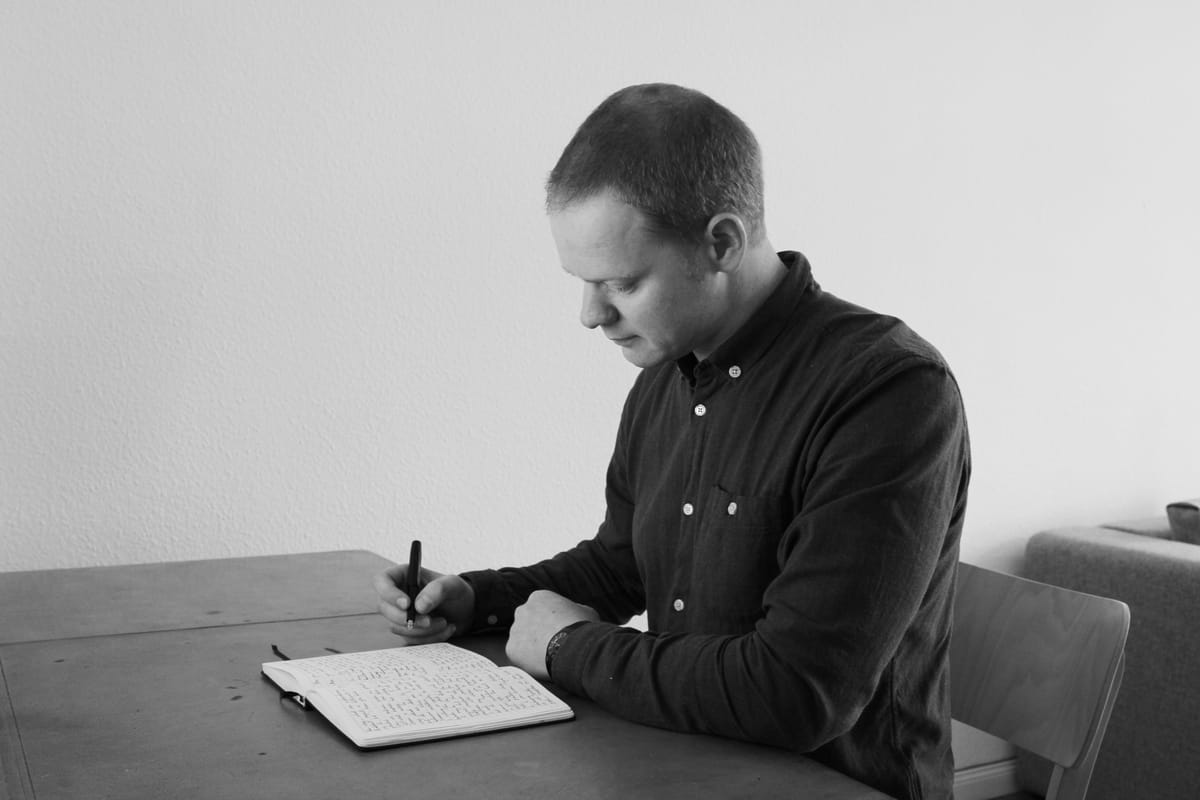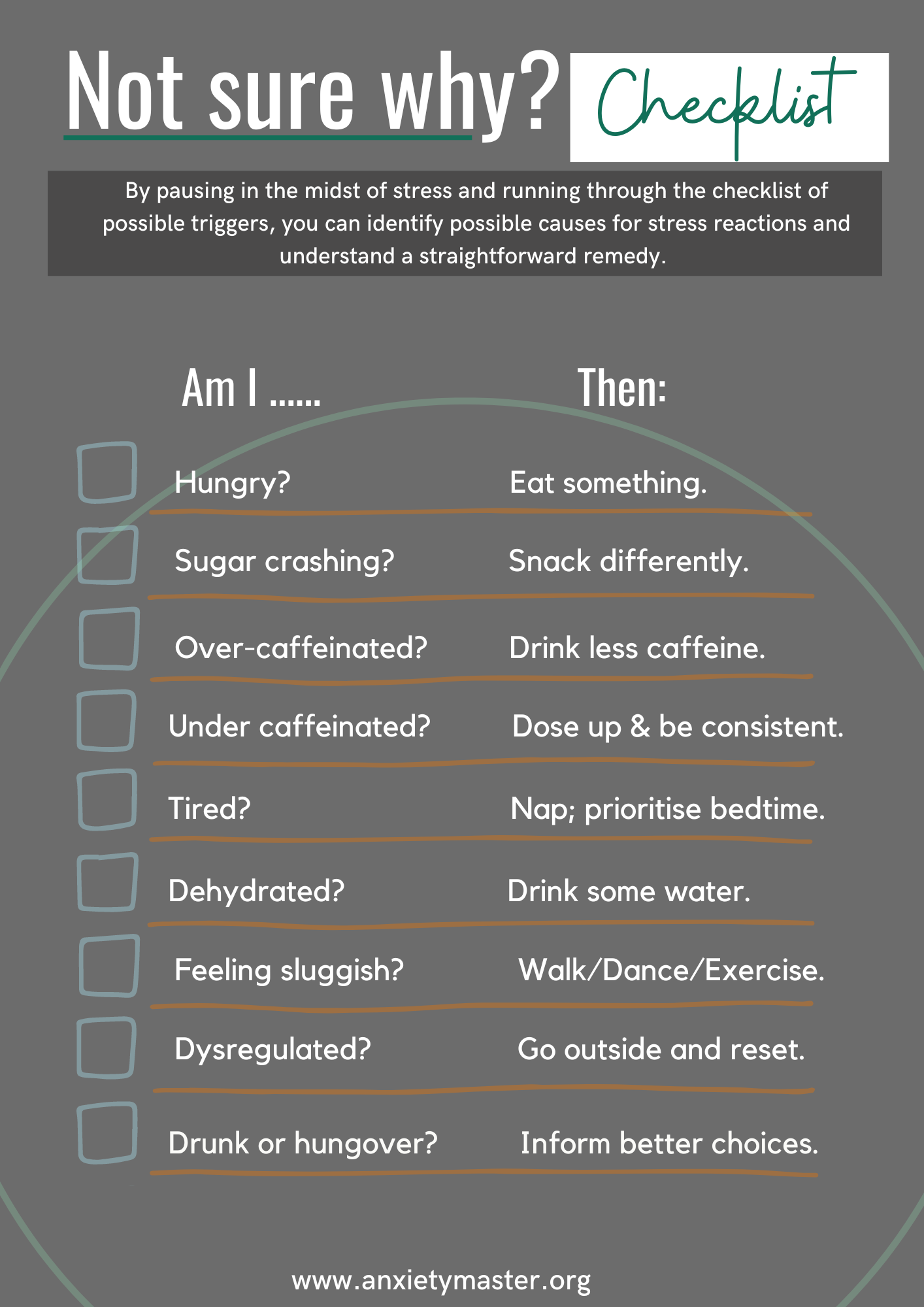The Truth About Anxiety: Identify False Alarms vs. True Anxiety for Better Control
Identity the difference between your body’s false alarms and true anxiety.

Action: Implement simple behaviour changes to address and reduce the physical triggers of anxiety.
Content: Uncover the difference between true and false anxiety to manage feelings of unease with greater clarity and confidence.
Outcome: Experience a calmer, more composed approach to anxiety by reducing unnecessary anxious feelings and consuming over-analysis.
Do you ever feel anxious or edgy for no clear reason?
Perhaps a tingle on your tongue or a slight unease in your stomach bursts forth from nowhere. Your thoughts race, your attention feels slippery, and suddenly, you're searching for answers—what’s wrong?
Is it nerves before tomorrow's meeting because you want it to go well?
Or is it lingering worry about a relationship in your life?
You scan your emotional landscape for clues to the cause of unease.
This extra scrutiny may make you feel more distracted, and anxiety may intensify. With your attention honed in on what's wrong, your well-intentioned brain assists the search, leading to cascading worries that overlook (potential) simple causes.
The good news is anxiety is often less complicated.
Rather than defaulting to complex interpretations for anxiety, it's reassuring - and more effective - to start with simple explanations for anxious feelings.
Many cases of anxiety are avoidable; the symptoms are easy to trace and remedy.
Yet, common causes of modern-day anxiety—grounded in daily habits—are easy to overlook.
In this article, we’ll break down how to tell whether your anxiety is rooted in true life challenges or simply the result of a physical imbalance, like hunger, poor sleep, or too much caffeine.
Understanding the difference will help you know when to lean into the emotional work needed and when to step back and address the basic restorations your body is calling for.
There's also a practical checklist to help you reflect on your daily habits and address common triggers of anxious feelings.
Now, you're already an expert in your experience of anxiety. Still, this sixty-second video will get us out of the starting blocks together ...
What is anxiety - and how does it relate to stress?
Anxiety is not a sign of weakness. It’s your body’s alarm system to stress when demands exceed your ability to cope.
Stress has a way of building up, much like a pot simmering on the stove. An argument here or a missed deadline there - each expanding the pressure to reduce your bandwidth over time.
Even positive shifts, such as starting a new job, getting married, or moving home, introduce demands that can leave you feeling pulled around.
Think of your ability to handle stress like an elastic band: stretched gently, it can expand and adapt to demonstrate its potential. But if pulled too far, it snaps.
Or imagine trying to carry too many grocery bags at once—at first, you think you can handle it, but soon, the weight starts digging in, and you're left trudging along.
Similarly, when stress becomes overwhelming, it pushes beyond your capacity. Left unaddressed, this pressure can manifest in anxiety - a signal that things aren't right.

Three Elements of Anxiety
At the heart of anxiety are three interlocking components: the physical sensations your body experiences, the emotions that arise in response, and the racing thoughts that tie it all together.
These three elements don't act in isolation—your heart racing from anxiety isn't just a symptom, it's a signal that emotions and thoughts are interacting in a cycle that can be hard to break.
By pinpointing the origins of such sensations, you can learn to intervene before the experience takes on a will of its own.
This is where the concept of true and false anxiety comes into play ...
Classifying Anxiety - True and False?
In her book, The Anatomy of Anxiety, Dr. Ellen Vora offers a clear lens to help distinguish the nature of common anxiety triggers. She uses the terms true anxiety and false anxiety to classify a difference.

Understanding a distinction between "true" and "false" anxiety will help to identify the source of your anxious feelings and how to attend to them effectively.
True Anxiety
True anxiety is your mind and body’s way of flagging that something significant is happening—whether it’s the deep ache of grief, the emotional toll of loss, the trepidation of navigating a tricky career change, or the uncertainty that comes with personal transitions.
These aren’t just fleeting moments of discomfort but deep emotional responses to meaningful events. True anxiety isn’t there to be dismissed—it’s a signal that steep challenges require your attention and care.
False Anxiety
False anxiety often sneaks in when your body is out of sync—think of the irritability that creeps up when you skip meals or the jittery unease after one too many coffees.
These aren't deep-rooted emotional crises; rather, your body is sending distress signals because it's not getting what it needs. In these moments, your brain can easily misinterpret these signals, spinning them into stories of worry or fear when the solution may be as simple as adjusting your daily habits.
When you learn to recognise the difference between true and false anxiety, you give yourself the power to respond more effectively.
True anxiety calls for deeper emotional work, perhaps reflecting on your life circumstances or seeking support. False anxiety, on the other hand, can often be tackled with small but impactful changes—getting more rest, adjusting your diet, or stepping outside for a break.
Understanding this distinction not only saves you from unnecessary worry but also restores a sense of control.
How True Anxiety Signals Deeper Issues
Case Study: Joan's True Anxiety
Joan would wake up with a feeling of dread she couldn't shake. Despite her successful career, she would lie in bed wondering why she felt so empty.
Her thoughts circled around her desire for connection and a family and the lingering fear that her career had pushed these dreams too far out of reach.
This is an example of true anxiety: Joan's distress was a natural response to significant, unresolved concerns overshadowing her personal life.

By recognising her anxiety as a signal to reflect on her life choices, Joan could begin addressing the root imbalances. True anxiety, like Joan’s, requires self-reflection and time to reevaluate and work through.
However, not all anxiety arises from deep emotional challenges. Anxiety doesn't always have a complicated origin; sometimes, it’s as simple as a lack of sleep, too much caffeine, or hunger driving jittery feelings.
Think about that sudden wave of anxiety you get when your stomach starts growling—your body is trying to tell you something. These physical cues often get overlooked, leading us down a rabbit hole of overthinking when the solution might be as simple as having a meal or drinking water.
This brings us to false anxiety, which can be more easily remedied through small adjustments, such as improving sleep habits or reducing caffeine intake.
Avoidable Moods, False Anxiety
In contrast to true anxiety, false anxiety is akin to an emotional imposter.
You might suddenly feel irritable, sad, angry, or anxious without a clear reason. In these moments, our minds try to make sense of these feelings by creating explanations:
- "Maybe I'm anxious because my boss's email seemed distant; perhaps I'm underperforming."
- "That text from my friend feels off; maybe something's wrong between us."
How we interpret our bodily sensations is a large part of how we experience them and record them in our memory.
Your brain is a natural storyteller, constantly trying to make sense of the world, even when the signals it's getting are purely physical. When you feel your heart race or your hands tremble, your mind leaps into action, assigning meaning where none may exist—‘Am I nervous about something?’ or ‘What’s wrong?’
In reality, the trigger could be something as simple as low blood sugar or dehydration. This mental storytelling can fuel unnecessary anxiety, making it harder to see the simpler solution
False Anxiety: The Role of Physical Imbalances
False anxiety often results from physiological issues:
- Nutritional deficiencies.
- Hormonal imbalances.
- Lack of sunlight or poor sleep.
Take a moment to reflect:
- Have you ever felt anxious or irritable, only to realise you hadn’t eaten or slept well?
- Do you notice that after too much caffeine, you feel jittery or tense?
- Could physical habits like dehydration or screen time be contributing to your anxious feelings?
False Anxiety is still real
Referring to these sensations as "false anxiety" doesn't diminish the reality of your distress—the pain is genuine.
The terms "true anxiety" and "false anxiety" don't represent value judgments; rather, they help differentiate the type of response and intervention required to address your anxiety.
When you address false anxiety by making simple adjustments—like hydrating, resting, or cutting back on caffeine—you free up your emotional energy to tackle the real challenges.
With false anxiety out of the way, you can focus on the deeper, more complex emotions that need your attention. This shift allows you to prioritise the things that truly matter rather than getting stuck in a loop of unnecessary worry.
So, next time you're feeling anxious without obvious cause, run through this checklist and see if you can pinpoint a simple explanation for uncomfortable sensations.
False Moods Anxiety - Physical Triggers Checklist
By pausing in the midst of turmoil and running through the following questions, we can identify specific physical stress triggers and take action to remedy them.
Hungry? (Eat something).
Sugar crashing or having a chemical comedown? (Did I just eat something sweet, processed, or laden with preservatives? Have a snack and focus on different choices next time).
Overcaffeinated? (Perhaps this jittery anxiety is really caffeine sensitivity; drink less caffeine tomorrow.
Undercaffeinated? (I drank less caffeine today than usual. Dose up and aim for consistent caffeine consumption).
Tired? (Take a nap; prioritise an earlier bedtime tonight.
Dehydrated? (Drink some water).
Feeling sluggish? (Take a quick walk outside; dance)
Dysregulated? (Did I just disappear down an online rabbit hole? Dance or go outside to reset the nervous system).
Drunk or hungover? (File this away to help inform better choices
Due for a dose of medication? (Right before the next dose, I’m at the nadir, and this can affect my mood. Time to take meds.

Summary: True Emotions vs False Moods
- Start with simple explanations for anxious feelings—physical triggers are often the root cause.
- Distinguish between 'true' anxiety (life challenges) and 'false' anxiety (physical imbalances) to address the source effectively.
- Use practical steps like eating, resting, or reducing caffeine to tackle false anxiety and restore capacity.
By consistently addressing false anxiety, you reclaim mental space and emotional energy, allowing you to face life’s deeper challenges with a clearer mind.
A message from Dominic:
Thanks for being here. I hope reading this article was worth your time.
I'd love to know if there's an area of mental health you'd like me to cover.
If so, I'd love you to write to me. Get in touch via contact on the homepage with feedback and suggestions.
I look forward to hearing from you : )
